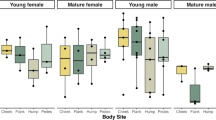Abstract
The odoriferous skin glands of the wild rabbit, Oryctolagus cuniculus which function for conspecific communication purposes have been the subject of intensive ethological and chemical studies. Volatile constituents of the anal and chin glands have been found to convey information concerning territoriality, whilst the odor of the secretion of inguinal glands conveys information about the identity and sex of an individual animal (Mykytowycz, 1965, 1966a,b; Hesterman and Mykytowycz, 1982). This paper reviews our knowledge of the chemistry of secretions from these glands.
Access this chapter
Tax calculation will be finalised at checkout
Purchases are for personal use only
Preview
Unable to display preview. Download preview PDF.
Similar content being viewed by others
References
Albone, E.S., and Perry, G.C., 1976. Anal sac secretion of the red fox, Vulpes vulpes; volatile fatty acids and diamines. Implications for a fermentation hypothesis of chemical recognition, J. Chem. Ecol. 2:101.
Berater, J., Beauchamp, G.K., and Muetterties, E.L., 1973, Complexity of chemical communication in mammals: urinary components mediating sex discrimination by male guinea pigs, Biochem. Biophys. Res. Comm. 53: 264.
Goodrich, B.S., and Mykytowycz, R., 1972, Individual and sex differences in the chemical composition of pheromone-like substances from the skin glands of the.rabbit, Oryctolagus cuniculus, J. Mammal. 53: 540.
Goodrich, B.S., Hesterman, E.R., Murray, K.E., Mykytowycz, R., Stanley, G., and Sugowdz, G., 1978, Identification of behaviorally significant volatile compounds in the anal gland of the rabbit, Oryctolagus cuniculus, J. Chem. Ecol. 4: 581.
Goodrich, B.S., Hesterman, E.R., Shaw, K.S., and Mykytowycz, R., 1981a, Identification of some volatile compounds in the odor of fecal pellets of the rabbit, Oryctolagus cuniculus, J. Chem.Ecol. 7:813.
Goodrich, B.S., Hesterman, E.R., and Mykytowycz, R., 1981b,. Effect of volatiles collected above fecal pellets on behavior of the rabbit, Oryctolagus cuniculus tested in an experimental chamber. II. Gas chromatographic fractionation of trapped volatiles, J. Chem. Ecol. 7:947.
Hesterman, E.R., Goodrich, B.S., and Mykytowycz, R., 1976, Behavioral and cardiac responses of the rabbit, Oryctolagus cuniculus to chemical fractions from anal gland, J. Chem. Ecol. 2: 25.
Hesterman, E.R., Goodrich, B.S., and Mykytowycz, R., 1981, Effect of volatiles collected abov fecal pellets on behavior of the rabbit, Oryctolagus cuniculus tested in an experimental chamber. I Total volatiles and some chemically prepared fractions, J. Chem. Ecol. 7:795.
Hesterman, E.R., and Mykytowycz, R., 1982, Misidentification by wild rabbits, Oryctolagus cuniculus of group members carrying the odor of foreign inguinal gland secretion. I. Experiments with all-male groups, J. Chem. Ecol. 8:419.
Merritt, G.C., Goodrich, B.S., Hesterman, E.R., and Mykytowycz, R., In press, The microflora and volatile fatty acids present in the inguinal pouches of the wild rabbit, Oryctolagus cuniculus in Australia, J. Chem. Ecol.
Mykytowycz, R., 1965, Further observations on the territorial function and histology of the submandibular cutaneous (chin) glands in the rabbit, Oryctolagus cuniculus (L.), Anim. Behay. 13: 400.
Mykytowycz, R., 1966a, Observations on odoriferous and other glands in the Australian wild rabbit, Oryctolagus cuniculus (L.) and the hare, Lepus europaeus P. I. The anal gland, CSIRO Wildl. Res. 11:11.
Mykytowycz, R. 1966b, Observation on odoriferous and other glands in the Australian wild rabbit, Oryctolagus cuniculus (L.) and the hare, Lepus europaeus P. II. The inguinal glands, CSIRO Wildl. Res. 11: 49.
Mykytowycz, R., 1968, Territorial marking by rabbits, Sci. Amer. 218:116.
Mykytowycz, R., 1975, Activation of territorial behaviour in the rabbit, Oryctolagus cuniculus by stimulation with its own chin gland secretion, in: “Olfaction and Taste, V”, D.A. Denton and J.P. Coghlan, eds., Academic Press, New York.
Mykytowycz, R., Hesterman, E.R., Gambale, S., and Dudzinski, M.L., 1976, A comparison of the effectiveness of the odors of rabbits, Oryctolagus cuniculus in enhancing territorial confidence, J. Chem. Ecol. 2:13.
Novotny, M., Jorgenson, J.W., Carmack, M., Wilson, S.R.,Boyse, E.A., Yamazaki, K., Wilson, M., Beamer, W., and Whitten, W.K.
Chemical studies of the primer mouse pheromones, in: “Chemical Signals: Vertebrates and Aquatic Invertebrates”, D. Muller-Schwarze and R.M. Silverstein, eds., Plenum Press, New York.
Singer, A.G., Macrides, F., and Agosta, W.C., 1980, Chemical studies of hamster reproductive pheromones, in: “Chemical Signals: Vertebrates and Aquatic Invertebrates”, D. Müller-Schwarze and R.M. Silverstein, eds., Plenum Press, New York.
Vandenbergh, J.G., 1980, The influence of pheromones on puberty in rodents, in: “Chemical Signals: Vertebrates and Aquatic Invertebrates”, D. Muller-Schwarze and R.M. Silverstein, eds., Plenum press, New York.
Wales, N.A.M., and Ebling, F.J., 1971, The control of the apocrine glands of the rabbit by steroid hormones, J. Endocr. 51:763.
Author information
Authors and Affiliations
Editor information
Editors and Affiliations
Rights and permissions
Copyright information
© 1983 Springer Science+Business Media New York
About this chapter
Cite this chapter
Goodrich, B.S. (1983). Studies of the Chemical Composition of Secretions from Skin Glands of the Rabbit Oryctolagus Cuniculus . In: Müller-Schwarze, D., Silverstein, R.M. (eds) Chemical Signals in Vertebrates 3. Springer, Boston, MA. https://doi.org/10.1007/978-1-4757-9652-0_18
Download citation
DOI: https://doi.org/10.1007/978-1-4757-9652-0_18
Publisher Name: Springer, Boston, MA
Print ISBN: 978-1-4757-9654-4
Online ISBN: 978-1-4757-9652-0
eBook Packages: Springer Book Archive




